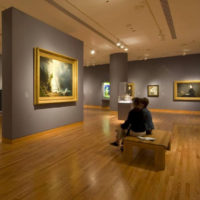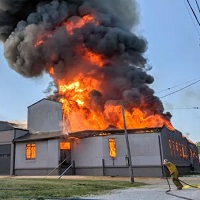AJ Four Ways:
Text Only (by date) | headlines only
- A Brief History Of The Word “Hello”
The greeting’s first known appearance in print happened 200 years ago this week in a Connecticut newspaper, but its roots go back at least two centuries further, probably more. – BBC
- Our Connection Between Athletics And Writing
The intensity of the workout was necessary to take her out of her head, so that she could write from a different place—“an embodied place, because writing is not just intellectual; it’s emotional connection, sensual connection,” she explained. “We exist in the world.” – The Atlantic
- The Virtuosic Female Musicians Who Attracted Rapt Listeners From All Over Europe
The women of 18th-century Venice’s ospedali (homes for the destitute, the sick, and orphans) are remembered largely because Vivaldi composed music for them. History has mostly overlooked them in favor of the famous men around them, but we now know that they were highly trained, ferociously talented, and deeply ambitious. – Early Music America
- London’s Gallery Commune Proves Sharing Is Caring
Ten years in, Condo’s cooperative model has emerging dealers singing Kumbaya while actually making money. Who knew that playing nice could be the art world’s best-kept business secret? — Artnet News
- Museums Having Identity Crisis, Film at Eleven
Another year, another promise to “redefine” art institutions. But this conversation with curator eunice bélidor and administrator Dejha Carrington might actually cut through the usual reform rhetoric to examine what museums are really for. — Hyperallergic
- South Africa Pulls Venice Biennale Show, Proving Art Diplomacy Dead
When your culture minister cancels a Palestinian grief exhibition for Venice, you’ve officially entered the realm where politics trumps artistic integrity. Two scholars aren’t having it, calling out the betrayal. — Hyperallergic
- How The Cleveland Orchestra Prepares For A Concert
It says a lot that this orchestra is confident enough to let a critic see it rehearse from start to finish, on the record. Perhaps it says more that I was not allowed to sit onstage, to guard against distractions. – The New York Times
- This Actress Has Starred In The Same Legendarily Bad Off-Broadway Show For 39 Years
“On TripAdvisor, one user warns: ‘Don’t waste your money!’ Another pleads: ‘Kill me now!’ And yet, since 1987, Perfect Crime has been running eight times a week. Every performance stars the same actress, Catherine Russell; in nearly four decades she has missed only four performances.” – The Times (UK)
- Here Are The Grants The New National Endowment For The Humanities Has Given
The National Endowment for the Humanities on Thursday announced $71 million in new grants, including nearly $40 million to classical humanities institutes and civic leadership programs that have been promoted by conservatives as a counterweight to liberal-dominated higher education. – The New York Times
- How We Lost The Art Of Paying Attention
Most of us are by now familiar with the broad mechanisms of the “attention economy” – the hijacking and monetising of consumer attention through addictive channels. The ravages of this system are ever more apparent. – The Observer
- More Trump-Taunting Art Placed On The National Mall
A massive replica of a birthday note and crude drawing signed with the typed name Donald J. Trump and a “Donald” signature that was part of a 2003 book of birthday wishes for the deceased convicted sex offender Jeffrey Epstein was placed on the National Mall early Monday morning. – Washington Post
- You’d Think Russian Censors Would Have Shut This Play Down. But It’s A Huge Hit.
“When an obscure play called The Kholops opened in St. Petersburg in 2024, many Russians raced to see it, fearful that the authorities would quickly shut (it) down. … Nearly two years later, the doors remain open and the seats packed for The Kholops, written in 1907 by Pyotr Gnedich.” – The New York Times
- The Death Of The 20th Century Mono-Culture (And What It Means)
The implications for the battered-and-bruised entertainment industry are obvious. The impacts on our culture are just starting to fully materialize, but will be more significant. Instead of pulling us together, pop culture is another force dragging us apart. – The Wall Street Journal
- Christmas Day Broke All Records For Streaming
Nielsen says streamers logged 55.1 billion minutes on streaming services on Christmas, breaking the previous high — set on Christmas in 2024 — by 3.9 billion minutes. That amounts to 54 percent of all TV use during the day, also an all-time high for streaming services. – The Hollywood Reporter
- Matt Damon: Movies Now Repeat Plots “Three Or Four Times” In Dialogue Because People Are On Their Phones While Watching
Because viewers give a “very different level of attention” to a movie at home versus in a theater, Netflix wants to push the action set pieces toward the front. He said there are behind-the-scenes discussions about reiterating “the plot three or four times in the dialogue” to account for people being on their phones. – Variety
- Despite Trump Administration Attacks, NEH Has Just Given $75 Million In Grants
“The National Endowment of the Humanities (NEH) has announced a new round of grants — $75.1m to 84 projects, many of them celebrating the US’s semiquincentennial. These are the first grants since the administration of president Donald Trump fired all but four members of the National Council on the Humanities … in October.” – The Art Newspaper
- Director Tina Packer, Founder Of Theater Troupe Shakespeare & Co., Is Dead At 87
“In 1978, Ms. Packer founded Shakespeare & Company with Kristin Linklater, a voice teacher; Dennis Krausnick, an actor, director and writer who later became Ms. Packer’s husband; and a group of other theater artists. An actress by training, Ms. Packer was the company’s artistic director until 2009.” – The New York Times
- Author Julian Barnes Says He Has Written His Last Book
“I won’t stop writing, because I’ve been a journalist all my life, before I became a novelist. So I shall do journalism, reviews and things like that. But in terms of books, this” — Departure(s) — “is my last.” – The Telegraph (UK) (Yahoo!)
- Zubin Mehta Cancels All Of His Performances In Israel This Year
The conductor, who was music director of the Israel Philharmonic for 39 years, retiring in 2020, said his decision to withdraw from concerts there was to protest Prime Minister Netanyahu’s policies toward the Palestinians. – Moto Perpetuo
- Starchitect Firm Snøhetta Accused Of Firing Employees For Unionizing
“In a complaint issued on Friday, a regional director of the National Labor Relations Board accused Snøhetta of illegally dismissing eight employees because they supported the union and ‘engaged in concerted activities’ — that is, collective action — ‘and to discourage employees from engaging in these activities.’” – The New York Times
- Netflix Changes Its Warner Bros. Bid To All-Cash
“Netflix’s all-cash offer of $27.75 per share replaces its previous offer of $23.25 in cash and $4.50 in Netflix common stock per share. The sweetened offer comes as rival bidder Paramount continues pushing its own all-cash offer for all of Warner Discovery. The value of Netflix’s offer remains $72 billion.” – The Wall Street Journal (MSN)
- Martha Graham Dance Company Is Latest To Cancel Kennedy Center Performances
The oldest dance company in the US had been scheduled to perform at the DC venue as part of its centennial tour. The brief statement announcing the cancellation mentioned no reason. – The Daily Beast
- Born in the DSA*: The Worst Healthcare System in the World Needs an UpgradeIt’s cheaper and more effective to keep people well than to make people well.
- Good Morning
Today’s AJ highlights: In Washington, the debate over the Kennedy Center’s business model has reached a point of absurdity, with critics warning that corporate aesthetic preferences are determining what counts as art at the nation’s premier center (Washington Post). This tension between commerce and culture is mirrored in the film industry, where Netflix is reportedly pushing for action movies that restate their plots multiple times in dialogue to keep phone-distracted viewers engaged (Variety).
The existential impact of Artificial Intelligence is being felt across the culture. Researchers argue that AI is a tool being used with “astonishing alacrity” to hollow out democratic institutions (Gary Marcus) , while others question if the next wave of technology will fundamentally change the nature of human attention (Big Think). The line between human and machine is further blurred by the rise of AI “singers” like Sienna Rose, whose synthesized tracks are built from refined white noise (BBC).
Travel bans and visa pauses are currently stymying international musicians, creating a logistical mess for U.S. audiences and producers (The New York Times). And we look at the Poverty of the Novelist, where even accomplished authors earn mere fragments of a living wage (The Guardian).
All our stories below.
- The Trump-Kennedy Center Regime’s Odd Notion Of An Arts Business Model
The notion that unstated corporate aesthetic preferences should determine what the public encounters as art — indeed, what counts as art at the nation’s art center — is absurd. It’s why we don’t (yet) have touring musicals about a young couple discovering the bold, zesty flavor of Cool Ranch Doritos. – Washington Post
- The Playboy Publisher Who Published The Greats And Shaped American Literature
Toward the end of his life, the versatile Bennett Cerf — believing that growth was essential — acquired rival publishing house Knopf. A few years later, he arranged for Random House to become a subsidiary of the RCA Corporation, then an electronics and communications leviathan. This move, Cerf soon recognized, was a mistake. – Washington Post
- We Think Time Always Moves Forward. This Is A Relatively New Concept
This picture of time is not natural. Its roots stretch only to the 18th century, yet this notion has now entrenched itself so deeply in Western thought that it’s difficult to imagine time as anything else. And this new representation of time has affected all kinds of things, from our understanding of history to time travel. – Aeon
- What If AI Changes The Very Nature Of Our Attention?
What if the next wave of artificial intelligence (AI) isn’t designed to feed that addiction — but to fundamentally change it? What if the future of AI demands young people’s attention, curiosity, and creativity in ways we haven’t experienced before? – Big Think
- Research Paper: How AI Is Destroying Institutions
If you wanted to create a tool that would enable the destruction of institutions that prop up democratic life, you could not do better than artificial intelligence. Authoritarian leaders and technology oligarchs are deploying AI systems to hollow out public institutions with an astonishing alacrity. – Gary Marcus
- The Private Museums Grappling With America’s Real History
The Legacy Museum, which opened almost eight years ago, is perhaps the closest thing America has to a national slavery museum. Crucially, however, it is completely privately funded, receiving no state or federal financial support. – The Atlantic
- What Happens When Art Attacks Power
Beginning in 1933, propagandistic art exhibitions were mounted throughout Germany. These “Schandausstellung” (modern art shame exhibitions) included the titles, “Art in the Service of Decay,” “Art Which Has Not Come from Our Soul,” “Horror Chambers of Art” and “Reflections of Degeneration in Art.” Artists themselves also faced pressure. – LMU
- What Happens When Your Orchestra Goes All In On Images In Performance And It Doesn’t Work
“I eventually stopped looking at the video, or tried to, as did my guest, but was then faced with the initial problem, that is, listening to a complete ballet, with its many discursions and tangents, in concert, without dancers.” – Classical Life
- Netflix Explains The Streamer’s Interest In Warner, And Commits To The Movie Theatre Business
“When this deal closes, we will own a theatrical distribution engine that is phenomenal and produces billions of dollars of theatrical revenue that we don’t want to put at risk. We will run that business largely like it is today, with 45-day windows.” – The New York Times
- The Poverty Of Being A Novelist
I’m a novelist, and I was paid £1,000 and £500 respectively for my last two books. The latter was shortlisted for an international literary award. That’s £1,500 earned in 10 years. – The Guardian
- Travel Bans From The US Administration Have Stymied Artists, Keeping Them From North America
This isn’t great for U.S. audiences either – or the producers and promoters trying to bring international artists. “It’s an unbelievable mess, … and no one can provide an answer.”- The New York Times





